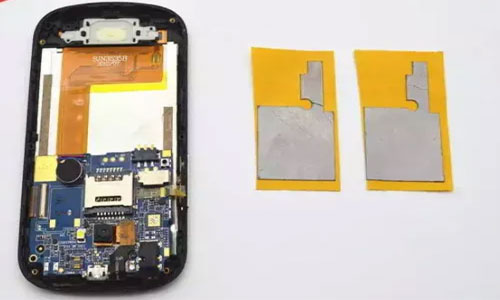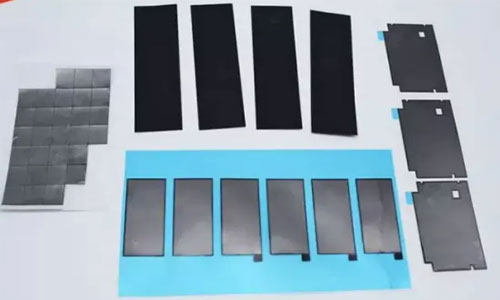With the development trend of ultra-thin, intelligent, and multifunctional consumer electronics, products are becoming more powerful, thinner, and increasingly exposing heat dissipation issues. Due to its outstanding thermal conductivity, thermal graphite sheets have gained increasing attention and are widely used in fields such as smartphones, ultra-thin computers, and LED TVs.

Due to its unique grain orientation, thermal graphite sheets conduct heat uniformly in both the X-Y and Z directions. The sheet structure can adapt well to the surface fluctuations of devices, and its unique crystal structure and processing method not only provide thermal insulation and shielding of heat sources and components but also offer uniform heat conduction, significantly improving the performance of electronic products.
What is a thermal graphite sheet?

A thermal graphite sheet is a new type of thermal conductive material that conducts heat uniformly in two directions, while providing heat shielding for heat sources and components, and improving the performance of consumer electronic products. As electronic products upgrade towards miniaturization, high integration, and high-performance, the demand for heat management also increases.
This new natural graphite solution has high heat dissipation, a small footprint, and light weight. It is generally black in color and made from refined natural graphite, with a horizontal thermal conductivity of up to 1500W / m-K. It is commonly used in ICs, CPUs, MOS, LEDs, heat sinks, LCD TVs, laptops, communication equipment, wireless switches, DVDs, handheld devices, and more.
Classification of thermal graphite sheets:
Graphite sheets can be divided into natural graphite sheets and artificial graphite sheets.
Natural graphite sheets have high thermal conductivity, are easy to work with, have good flexibility, are impermeable to gases and liquids, and do not age or become brittle. They are suitable for most chemical media and generally have a thermal conductivity coefficient range of 700-1200W/m·K. The drawback of natural graphite sheets is that they cannot be too thin. Typically, the thickness of finished boards can go down to 0.1mm. Therefore, the market share of natural graphite is decreasing, and the cooling effect of natural graphite is relatively weak due to its structural factors.
Artificial graphite sheets can be made very thin and have excellent heat dissipation performance, with a thermal conductivity coefficient ranging from 1000-1500W/m·K, mainly reflecting their ability to dissipate heat quickly. However, artificial graphite is expensive. In terms of pursuing quality in the mobile phone market, artificial graphite sheets are also becoming popular.
Cooling principle of graphite sheets:
A typical thermal management system consists of an external cooling device, a heat sink, and a heat dissipating part. Taking smartphones as an example:
1. Heat is rapidly transferred to the casing and frame through the plane of the thermal graphite sheet.
2. The thermal graphite sheet enhances the infrared radiation effect on its surface.
3. The thermal graphite sheet expands the surface area for heat dissipation, quickly eliminating hotspots.
Relevant parameters of thermal graphite sheets:
Thin film polymer compounds can undergo chemical graphitization under high temperature and pressure. As carbon is a non-metallic element, it has the electrical and thermal properties of metallic materials, as well as the plasticity of organic plastics. It also possesses special thermal properties, chemical stability, lubricity, and the ability to coat solid surfaces. Furthermore, it demonstrates good processability.
Therefore, thermal graphite has been widely used in various fields such as electronics, communications, lighting, aviation, and defense. Graphite thermal materials provide a unique combination of high performance and unique solutions for the thermal management industry.
Scope of thermal graphite sheet die cutting process:
Thermal graphite materials bring new technical solutions to the increasingly widespread industrial heat dissipation needs through a variety of different thermal management applications. Thermal graphite material products provide innovative new technologies for the thermal management of the electronic industry. Thermal graphite provides better thermal conductivity while reducing the weight of equipment. Thermal graphite heat dissipation solutions are new applications in thermal design.
The surface of thermal graphite can be combined with metals, plastics, stickers, and other materials to meet various design features and requirements.
Low thermal resistance: 40% lower thermal resistance than aluminum and 20% lower than copper.
Lightweight: 25% lighter than aluminum and 75% lighter than copper.
High thermal conductivity: Graphite heat dissipation sheets can be smoothly connected to any flat and curved surfaces, and can be cut in any way according to customer requirements.
Die cutting and forming of thermal graphite sheets:
In order to better adapt to the uneven surfaces of electronic devices and circuit modules, it is necessary to perform certain treatments on thermal graphite sheets. The main processing methods are:
1. Adhesive die cutting processing: To better bond ICs and circuit boards, adhesive treatment is performed on the surface of thermal graphite sheets.
2. Back film die cutting: In some circuit designs that require insulation or heat insulation for better functional optimization, back film treatment is done on the surface of the graphite sheet.
We can select the appropriate die cutting method based on the actual needs of the product.
Applications of thermal graphite sheets in smartphones:
The CPU speed used in smartphones is continually increasing, memory capacity is expanding, and operating system performance is improving. The demand for heat dissipation in ultra-thin bodies is gradually increasing. Currently, more and more smartphones sold in the domestic market, such as Apple, Samsung, HTC, Xiaomi, etc., are adopting graphite sheets as thermal conductive materials.
Contact: Pamela
Phone: +86 189 6365 3253
E-mail: info@industryprocess.com
Whatsapp:+86 189 6365 3253
Add: Yajing Industrial Park, No. 59 Shuangjing Street, Weiting Town, Suzhou Industrial Park
We chat
